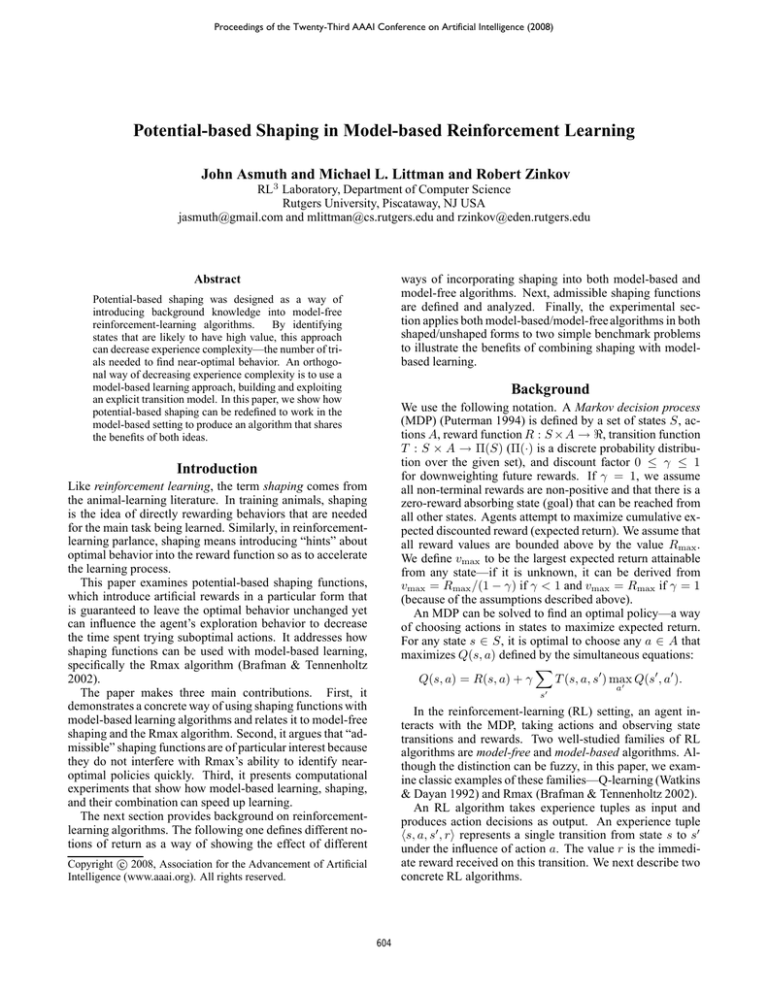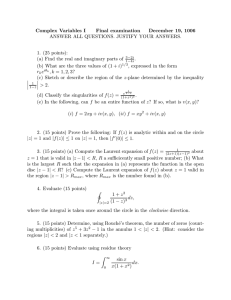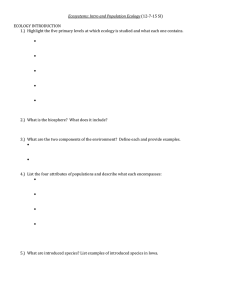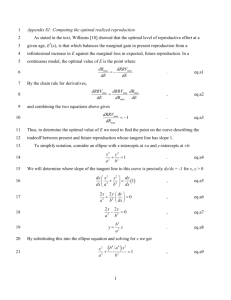
Proceedings of the Twenty-Third AAAI Conference on Artificial Intelligence (2008)
Potential-based Shaping in Model-based Reinforcement Learning
John Asmuth and Michael L. Littman and Robert Zinkov
RL3 Laboratory, Department of Computer Science
Rutgers University, Piscataway, NJ USA
jasmuth@gmail.com and mlittman@cs.rutgers.edu and rzinkov@eden.rutgers.edu
ways of incorporating shaping into both model-based and
model-free algorithms. Next, admissible shaping functions
are defined and analyzed. Finally, the experimental section applies both model-based/model-free algorithms in both
shaped/unshaped forms to two simple benchmark problems
to illustrate the benefits of combining shaping with modelbased learning.
Abstract
Potential-based shaping was designed as a way of
introducing background knowledge into model-free
reinforcement-learning algorithms.
By identifying
states that are likely to have high value, this approach
can decrease experience complexity—the number of trials needed to find near-optimal behavior. An orthogonal way of decreasing experience complexity is to use a
model-based learning approach, building and exploiting
an explicit transition model. In this paper, we show how
potential-based shaping can be redefined to work in the
model-based setting to produce an algorithm that shares
the benefits of both ideas.
Background
We use the following notation. A Markov decision process
(MDP) (Puterman 1994) is defined by a set of states S, actions A, reward function R : S × A → ℜ, transition function
T : S × A → Π(S) (Π(·) is a discrete probability distribution over the given set), and discount factor 0 ≤ γ ≤ 1
for downweighting future rewards. If γ = 1, we assume
all non-terminal rewards are non-positive and that there is a
zero-reward absorbing state (goal) that can be reached from
all other states. Agents attempt to maximize cumulative expected discounted reward (expected return). We assume that
all reward values are bounded above by the value Rmax .
We define vmax to be the largest expected return attainable
from any state—if it is unknown, it can be derived from
vmax = Rmax /(1 − γ) if γ < 1 and vmax = Rmax if γ = 1
(because of the assumptions described above).
An MDP can be solved to find an optimal policy—a way
of choosing actions in states to maximize expected return.
For any state s ∈ S, it is optimal to choose any a ∈ A that
maximizes Q(s, a) defined by the simultaneous equations:
X
Q(s, a) = R(s, a) + γ
T (s, a, s′ ) max
Q(s′ , a′ ).
′
Introduction
Like reinforcement learning, the term shaping comes from
the animal-learning literature. In training animals, shaping
is the idea of directly rewarding behaviors that are needed
for the main task being learned. Similarly, in reinforcementlearning parlance, shaping means introducing “hints” about
optimal behavior into the reward function so as to accelerate
the learning process.
This paper examines potential-based shaping functions,
which introduce artificial rewards in a particular form that
is guaranteed to leave the optimal behavior unchanged yet
can influence the agent’s exploration behavior to decrease
the time spent trying suboptimal actions. It addresses how
shaping functions can be used with model-based learning,
specifically the Rmax algorithm (Brafman & Tennenholtz
2002).
The paper makes three main contributions. First, it
demonstrates a concrete way of using shaping functions with
model-based learning algorithms and relates it to model-free
shaping and the Rmax algorithm. Second, it argues that “admissible” shaping functions are of particular interest because
they do not interfere with Rmax’s ability to identify nearoptimal policies quickly. Third, it presents computational
experiments that show how model-based learning, shaping,
and their combination can speed up learning.
The next section provides background on reinforcementlearning algorithms. The following one defines different notions of return as a way of showing the effect of different
s′
a
In the reinforcement-learning (RL) setting, an agent interacts with the MDP, taking actions and observing state
transitions and rewards. Two well-studied families of RL
algorithms are model-free and model-based algorithms. Although the distinction can be fuzzy, in this paper, we examine classic examples of these families—Q-learning (Watkins
& Dayan 1992) and Rmax (Brafman & Tennenholtz 2002).
An RL algorithm takes experience tuples as input and
produces action decisions as output. An experience tuple
hs, a, s′ , ri represents a single transition from state s to s′
under the influence of action a. The value r is the immediate reward received on this transition. We next describe two
concrete RL algorithms.
c 2008, Association for the Advancement of Artificial
Copyright Intelligence (www.aaai.org). All rights reserved.
604
Q-learning is a model-free algorithm that maintains an estimate Q̂ of the Q function Q. Starting from some initial values, each experience tuple hs, a, s′ , ri changes the Q function estimate via
Q̂(s, a) ←α r + γ max
Q̂(s′ , a′ ),
′
nal notion of return, shaped return, Rmax return, and finally
shaped Rmax return.
Original Return
Let’s consider an infinite sequence of states, actions, and
rewards: s̄ = s0 , a0 , r0 , . . . , st , at , rt , . . .. In the discounted framework,
the return for this sequence is taken to
P∞
be U (s̄) = i=0 γ i ri .
Note that the Q function for any policy can be decomposed into an average of returns like this:
X
Q(s, a) =
Pr(s̄|s, a)U (s̄).
a
where α is a learning rate and “x ←α y” means that x is
assigned the value (1 − α)x + αy. The Q function estimate is used to make an action decision in state s ∈ S, usually by choosing the a ∈ A such that Q̂(s, a) is maximized.
Q-learning is actually a family algorithms. A complete Qlearning specification includes rules for initializing Q̂, for
changing α over time, and for selecting actions. The primary theoretical guarantee provided by Q-learning is that Q̂
converges to Q in the limit of infinite experience if α is decreased at the right rate and all s, a pairs begin an infinite
number of experience tuples.
A prototypical model-based algorithm is Rmax, which
creates “optimistic” estimates T̂ and R̂ of T and R.
Specifically, Rmax hypothesizes a state smax such that
T̂ (smax , a, smax ) = 1, R̂(smax , a) = 0 for all a. It also initializes T̂ (s, a, smax ) = 1 and R̂(s, a) = vmax for all s and
a. (Unmentioned transitions have probability 0.) It keeps
a transition count c(s, a, s′ ) and a reward total t(s, a), both
initialized to zero. In its practical form, it also has an integer
parameter m ≥ 0. Each experience tuple hs, a, s′ , ri re′
sults in an update c(s,
a, s′ ) + 1 and t(s, a) ←
Pa, s ) ← c(s,
′
t(s, a)+r. Then, if s′ c(s, a, s ) = m, the algorithm modifies T̂ (s, a, s′ ) = c(s, a, s′ )/m and R̂(s, a) = t(s, a)/m.
At this point, the algorithm computes
X
T̂ (s, a, s′ ) max
Q̂(s′ , a′ )
Q̂(s, a) = R̂(s, a) + γ
′
s′
s̄
Here, with the averaging weights Pr(s̄|s, a) depend on the
likelihood of the sequence as determined by the dynamics of
the MDP and the agent’s policy.
Shaping Return
In potential-based shaping (Ng, Harada, & Russell 1999),
the system designer provides the agent with a shaping function Φ(s), which maps each state to a real value. For shaping
to be successful, it is noted that Φ should be higher for states
with higher return.
The shaping function is used to modify the reward for a
transition from s to s′ by adding F (s, s′ ) = γΦ(s′ ) − Φ(s)
to it. The Φ-shaped return for s̄ becomes
UΦ (s̄)
a
=
∞
X
γ i (ri + F (si , si+1 ))
=
i=0
∞
X
γ i (ri + γΦ(si+1 ) − Φ(si ))
=
∞
X
i=0
for all state–actions pairs. When in state s, the algorithm
chooses the action that maximizes Q̂(s, a). Rmax guarantees, with high probability, that it will take near-optimal actions on all but a polynomial number of steps if m is set
sufficiently high (Kakade 2003).
PWe refer ′ to any state–action pair s, a such that
s′ c(s, a, s ) < m as unknown and otherwise known.
Notice that, each time a state–action pair becomes known,
Rmax performs a great deal of computation, solving an approximate MDP model. In contrast, Q-learning consistently
has low per-experience computational complexity. The principle advantage of Rmax, then, is that it makes more efficient
use of the experience it gathers at the cost of increased computational complexity.
Shaping and model-based learning have both been shown
to decrease experience complexity compared to a straightforward implementation of Q-learning. In this paper, we
show that the benefits of these two ideas are orthogonal—
their combination is more effective than either approach
alone. The next section formalizes the effect of potentialbased shaping in both model-free and model-based settings.
γ i ri +
i=0
= U (s̄) +
∞
X
i=0
∞
X
γ i+1 Φ(si+1 ) −
∞
X
γ i Φ(si )
i=0
∞
X
γ i Φ(si ) − Φ(s0 ) −
i=1
γ i Φ(si )
i=1
= U (s̄) − Φ(s0 ).
That is, the shaped return is the (unshaped) return minus
the shaping function’s value for the starting state. Since
the shaped return UΦ does not depend on the actions or
any states past the initial state, the shaped Q function is
similarly just a shift downward for each state: QΦ (s, a) =
Q(s, a)− Φ(s). Therefore, the optimal policy for the shaped
MDP (the MDP with shaping rewards added in) is precisely
the same as that of the original MDP (Ng, Harada, & Russell
1999).
Rmax Return
In the context of the Rmax algorithm, at an intermediate
stage of learning, the algorithm has built a partial model of
the environment. In the known states, accurate estimates of
the transitions and rewards are available. When an unknown
state is reached, the agent assumes its value is vmax , that is,
an upper bound on the largest possible value.
Comparing Definitions of Return
We next discuss several notions of how a trajectory is summarized by a single value, the return. We address the origi-
605
Note that we can achieve equivalent behavior to Rmax
with shaping by only modifying the reward for unknown
state–action pairs. That is, if we define the reward for
the first transition from a known state s to an unknown
state s′ as being incremented by Φ(s′ ), precisely the same
exploration policy results. This equivalence between two
views of model-based shaping approaches is reminiscent of
the equivalence between potential-based shaping and valuefunction initialization in the model-free setting (Wiewiora
2003).
For simplicity of analysis, we consider how the notion of
return is adapted in the Rmax framework if all rewards take
on their true values until an unknown state–action pair is
reached. In this setting, the estimated return for a trajectory
in Rmax is
URmax (s̄)
=
T
−1
X
γ i ri + γ T vmax ,
i=0
where sT , aT is the first unknown state–action pair in the
sequence s̄. Thus, the Rmax return is taken to be the
truncated return plus a discounted factor of vmax that depends only on the timestep on which an unknown state is
reached. Note that the Rmax return for a trajectory s̄ that
does not reach an unknown state is precisely the original return, URmax (s̄) = U (s̄).
Admissible Shaping Functions
As mentioned earlier, Q-learning comes with a guarantee
that the estimated Q values will converge to the true Q values
given that all state–action pairs are sampled infinitely often
and that the learning rate is decayed appropriately (Watkins
& Dayan 1992). Because of the properties of potential-based
shaping functions (Ng, Harada, & Russell 1999), these guarantees also hold for Q-learning with shaping. So, adding
shaping to Q-learning results in an algorithm with the same
asymptotic guarantees and the possibility of learning much
more rapidly.
Rmax’s guarantees are of a different form. Given that the
m parameter is set appropriately as a function of parameters
δ > 0 and ǫ > 0, Rmax achieves a guarantee known as PACMDP (probably approximately correct for MDPs) (Brafman
& Tennenholtz 2002; Ng, Harada, & Russell 1999; Strehl,
Li, & Littman 2006). Specifically, with probability 1 − δ,
Rmax will execute a policy that is within ǫ of optimal on
all but a polynomial number of steps. The polynomial in
question depends on the size of the state space |S|, the size
of the action space |A|, 1/δ, 1/ǫ, Rmax , and 1/(1 − γ).
Next, we argue that Rmax with shaping is also PAC-MDP
if and only if it uses an admissible shaping function.
Shaped Rmax Return
We next define a new notion of return that involves shaping
and known/unknown states and relate it Rmax.
This definition of return shapes all the rewards from transitions between known states:
UΦRmax (s̄)
=
T
−1
X
=
T
−1
X
γ i (ri + F (si , si+1 ))
i=0
γ i ri − Φ(s0 ) + γ T Φ(sT )
i=0
= URmax (s̄) − γ T vmax − Φ(s0 ) + γ T Φ(sT ).
Note that in an MDP in which all state–action pairs are
known, this equation is algebraically equivalent to UΦ (s̄) (T
is effectively infinite). So, this rule can be seen as a generalization of shaping to a setting in which there are both known
and unknown states.
Also, if we take Φ(s) = vmax , we have UΦRmax (s̄) =
URmax (s̄) − vmax . That is, the result is precisely the Rmax
return shifted by the constant vmax . It is interesting to note
that this choice of shaping function results in precisely the
original Rmax algorithm. That is, since the Q function is
shifted by a constant, an agent following the Rmax algorithm and one following this shaped version of Rmax would
make precisely the same sequence of actions. Thus, this rule
can also be seen as a generalization of Rmax to a setting in
which a more general shaping function can be used.
In its general form, the return of this rule is like that
of Rmax, except shifted down by the shaped value of the
starting state (which has no impact on the optimal policy)
and then shifted up by a discounted factor of the first state
reached from which an unknown action is taken. This application of the shaping idea encourages the agent to explore
unknown states with higher values of Φ(s). In addition, if
γ < 1, nearby states are more likely to be chosen first. As a
result, it captures the same intuition for shaping that drives
its use in the Q-learning setting—when faced with an unfamiliar situation, explore states with higher values of the
shaping function. For this reason, we refer to this algorithm
as “Rmax with shaping”.
Definition
It is well known from the field of search that heuristic functions can significantly speed up the process of finding a
shortest path to a goal. A heuristic function is called admissible if it assigns a value to every state in the search
space that is no larger than the shortest distance to the goal
for that state. Admissible heuristics can speed up search in
the context of the A∗ algorithm without the possibility of
the search finding a longer-than-necessary path (Russell &
Norvig 1994). Similar ideas have been used in the MDP setting (Hansen & Zilberstein 1999; Barto, Bradtke, & Singh
1995), so the importance of admissibility in search is well
established.
In the context of Rmax, we define a shaping function Φ
to be an admissible shaping function for an MDP if Φ(s) ≥
V (s), where V (s) = maxa Q(s, a). That is, the shaping
function is an upper bound on the actual value of the state.
Note that Φ(s) = vmax (the unshaped Rmax algorithm) is
admissible.
Properties
Admissible shaping functions have two properties that make
them particularly interesting. First, if Φ is admissible, then
606
Rmax with shaping is PAC-MDP. Second, if Φ is not admissible, then Rmax with shaping need not be PAC-MDP.
To justify the first claim, we build on the results of Strehl,
Li, & Littman (2006). In particular, Proposition 1 of that
paper showed that an algorithm is PAC-MDP if it satisfies
three properties—optimism, accuracy, and bounded learning
complexity. In the case of Rmax with shaping, accuracy
and bounded learning complexity follow precisely from the
original Rmax analysis (assuming, reasonably, that Φ(s) ≤
vmax ). Optimism here means that the Q function estimate
Q̂ is unlikely to be more than ǫ below the Q function Q (or,
in this case, QΦ ). This property can be proven from the
admissibility property of Φ:
Q̂(s, a)
X
=
Pr(s̄|s, a)UΦRmax (s̄)
s̄
=
X
≥
X
Pr(s̄|s, a)(URmax (s̄) − γ T vmax − Φ(s0 ) + γ T Φ(sT ))
s̄
Pr(s̄|s, a)(U (s̄) − Φ(s0 ))
Figure 1: A 15x15 grid with a fixed start (S) and goal (G)
location. Gray squares are episode-ending pits.
s̄
=
=
Q(s, a) − Φ(s0 )
QΦ (s, a).
Thus, running Rmax with any admissible shaping function
leads to a PAC-MDP learning algorithm.
Figure 2(a) demonstrates why not using an admissible
shaping function can cause problems for Rmax with shaping. Consider the case where s0 and s1 are known and s2 is
unknown. Rewards are zero and vmax = 0. So, Q̂(s0 , a1 ) =
V (s1 ) and Q̂(s0 , a2 ) = Φ(s2 ). If V (s1 ) > Φ(s2 ), the agent
will never feel the need to take action a1 when in state s0 ,
since it believes that such a policy would be suboptimal.
However, if V (s2 ) > V (s1 ), which can happen if Φ is not
admissible, the agent will behave suboptimally indefinitely.
(a)
(b)
Figure 2: (a) Simple MDP to illustrate why inadmissible
shaping functions can lead to learning suboptimal policies.
(b) A 4x6 grid.
Experiments
We evaluated six algorithms to observe the effects shaping
has on a model-free algorithm, Q-learning, a model-based
algorithm, Rmax, and ARTDP (Barto, Bradtke, & Singh
1995), which has elements of both. We ran the algorithms
in two novel test environments.1
RTDP (Real-Time Dyanmic Programming) is an algorithm for solving MDPs with known connections to the theory of admissible heuristic. The RL version, Adaptive RTDP
(ARTDP), combines learning models and heuristics and is
therefore a natural point of comparison for Rmax with shaping. Lacking adequate space for a detailed comparison, we
note that ARTDP is like Rmax with shaping except with
(1) m = 1, (2) Boltzmann exploration, and (3) incremental
planning. Difference (1) means ARTDP is not PAC-MDP.
Difference (3) means its per-experience computational complexity is closer to that of Q-learning. In our tests, we ran
ARTDP with exploration parameters Tmax = 100, Tmin =
.01, and β = .996, which seemed to strike an acceptable
balance between exploration and exploitation.
We ran Q-learning with 0.10 greedy exploration (it chose
the action with the highest estimated Q value with probability 0.90 and otherwise a random action) and α = 0.02.
These previously published settings (Ng, Harada, & Russell
1999) were not optimized for the new environments. Rmax
used a known-state parameter of m = 5 and all reported results were averaged over forty replications to reduce noise.
For experiments, we used maze environments with dynamics similar to those published elsewhere (Russell &
Norvig 1994; Leffler, Littman, & Edmunds 2007). Our first
environment consisted of a 15x15 grid (Figure 1). It has start
(S) and goal (G) locations, gray squares representing pits,
and dark lines representing impassable walls. The agent receives a reward of +1 for reaching the goal, −1 for falling
into a pit, and a −0.001 step cost. Reaching the goal or a pit
1
The benchmark environments used by Ng, Harada, & Russell (1999) were not sufficiently challenging—Q-learning with
shaping learned almost instantly in these problems.
607
1000
ARTDP with heuristic
Rmax with shaping
Rmax
ARTDP
Q-learning with shaping
500
cumulative reward
Q-learning
0
-500
-1000
-1500
-2000
0
200
400
600
800
1000
1200
1400
episodes
Figure 3: A cumulative plot of the reward received over 1500 learning episodes in the 15x15 grid example.
1500
Rmax with shaping
Rmax
ARTDP with heuristic
ARTDP
Q-learning with shaping
1000
cumulative reward
Q-learning
500
0
-500
-1000
-1500
0
500
1000
1500
2000
episodes
Figure 4: A cumulative plot of the reward received over the first 2000 learning episodes in the 4x6 grid example.
608
ends an episode and γ = 1.
Actions move the agent in each of the 4 compass directions, but actions can fail with probability 0.2, resulting in a
slip to one side or the other with equal probability. For example, if the agent chooses action “east” from the location
right above the start state, it will go east with probability 0.8,
south with probability 0.1, and north with probability 0.1.
Movement that would take the agent through a wall results
in no change of state.
In the experiments presented, the shaping function was
Φ(s) = C × D(s)
ρ + G, where C ≤ 0 is the per-step cost,
D(s) is the distance of the shortest path from s to the goal, ρ
is the probability that the agent goes in the direction intended
and G is the reward for reaching the goal. D(s)
is a lower
ρ
bound on the expected number of steps to reach the goal,
since every step the agent makes (using the optimal policy)
has chance ρ of succeeding. The ignored chance of failure
makes Φ admissible.
Figure 3 shows the cumulative reward obtained by the six
algorithms in 1500 learning episodes. In this environment,
without shaping, the agents are reduced to exploring randomly from the start state, very often ending up in a pit before stumbling across the goal. ARTDP and Q-learning have
a very difficult time locating the goal until around 1500 and
8000 episodes, respectively (not shown). Rmax, in contrast,
explores more systematically and begins performing well after approximately 900 episodes.
The admissible shaping function leads the agents toward
the goal more effectively. Shaping helps Q-learning master
the problem in about half the time. Similarly, Rmax with
shaping succeeds in about half the time of Rmax. Using
the shaping function as a heuristic (initial Q values), helps
ARTDP most of all; its aggressive learning pays off after
about 300 steps.
In this example, ARTDP outperformed Rmax using the
same heuristic. To achieve its PAC-MDP property, Rmax is
conservative. We constructed a modified maze, Figure 2(b),
to demonstrate the benefit of this assumption. We modified
the environment by changing the step cost to −0.1 and the
goal reward to +5 and adding a “reset” action that teleported
the agent back to the start state incurring the step cost. Otherwise, the structure is the same as the previous maze. The
optimal policy is to walk the “bridge” lined by risky pits
(akin to a combination lock).
Figure 4 presents the results of the six algorithms. The
main difference from the 15x15 maze is that ARTDP is not
able to find the optimal path reliably, even using the heuristic. The reason is that there is a high probability that it will
fall into a pit the first time it walks on the bridge. It models
this outcome as a dead end, resisting future attempts to sample that action. Increasing the exploration rate could help
prevent this modeling error but at the cost of the algorithm
randomly resetting much more often, hurting its opportunity
to explore.
potential-based shaping, a method for introducing “hints”
to the learning agent. We argued that, for shaping functions
that are “admissible”, this algorithm retains the formal guarantees of Rmax, a PAC-MDP algorithm. Finally, we showed
that the resulting combination of model learning and reward
shaping can learn near optimal policies more quickly than
either innovation in isolation.
In this work, we did not examine how shaping can best
be combined with methods that generalize experience across
states. However, our approach meshes naturally with existing Rmax enhancements along these lines such as factored
Rmax (Guestrin, Patrascu, & Schuurmans 2002) and RAMRmax (Leffler, Littman, & Edmunds 2007). Of particular
interest in future work will be integrating these ideas with
more powerful function approximation in the Q functions or
the model to help the methods scale to larger state spaces.
Acknowledgments
The authors thank DARPA TL and NSF CISE for their generous support.
References
Barto, A. G.; Bradtke, S. J.; and Singh, S. P. 1995. Learning to
act using real-time dynamic programming. Artificial Intelligence
72(1):81–138.
Brafman, R. I., and Tennenholtz, M. 2002. R-MAX—a general
polynomial time algorithm for near-optimal reinforcement learning. Journal of Machine Learning Research 3:213–231.
Guestrin, C.; Patrascu, R.; and Schuurmans, D. 2002. Algorithmdirected exploration for model-based reinforcement learning in
factored MDPs. In Proceedings of the International Conference
on Machine Learning, 235–242.
Hansen, E. A., and Zilberstein, S. 1999. Solving Markov decision problems using heuristic search. In Proceedings of the AAAI
Spring Symposium on Search Techniques for Problem Solving Under Uncertainty and Incomplete Information, 42–47.
Kakade, S. M. 2003. On the Sample Complexity of Reinforcement Learning. Ph.D. Dissertation, Gatsby Computational Neuroscience Unit, University College London.
Leffler, B. R.; Littman, M. L.; and Edmunds, T. 2007. Efficient reinforcement learning with relocatable action models. In
Proceedings of the Twenty-Second Conference on Artificial Intelligence (AAAI-07).
Ng, A. Y.; Harada, D.; and Russell, S. 1999. Policy invariance
under reward transformations: Theory and application to reward
shaping. In Proceedings of the Sixteenth International Conference
on Machine Learning, 278–287.
Puterman, M. L. 1994. Markov Decision Processes—Discrete
Stochastic Dynamic Programming. New York, NY: John Wiley
& Sons, Inc.
Russell, S. J., and Norvig, P. 1994. Artificial Intelligence: A
Modern Approach. Englewood Cliffs, NJ: Prentice-Hall.
Strehl, A. L.; Li, L.; and Littman, M. L. 2006. PAC reinforcement learning bounds for RTDP and rand-RTDP. In AAAI 2006
Workshop on Learning For Search.
Watkins, C. J. C. H., and Dayan, P. 1992. Q-learning. Machine
Learning 8(3):279–292.
Wiewiora, E. 2003. Potential-based shaping and Q-value initialization are equivalent. Journal of Artificial Intelligence Research
19:205–208.
Conclusions
We have defined a novel reinforcement-learning algorithm
that extends both Rmax, a model-based approach, and
609






